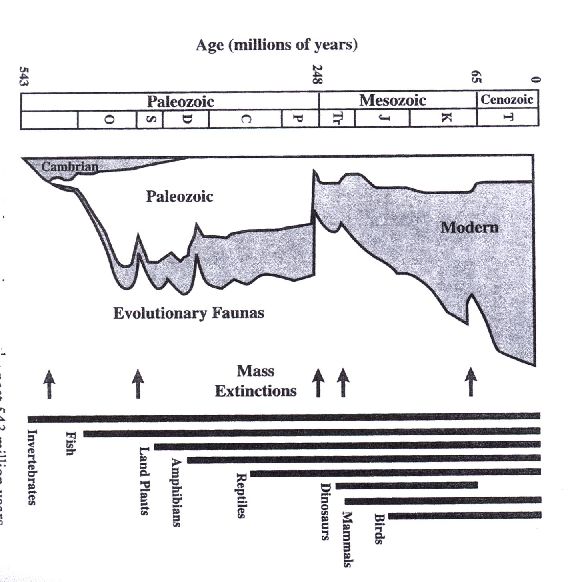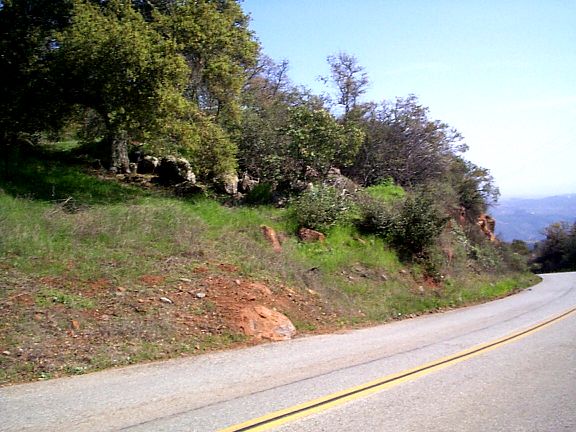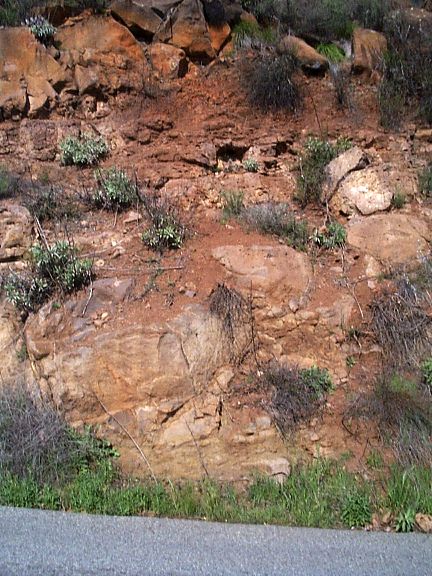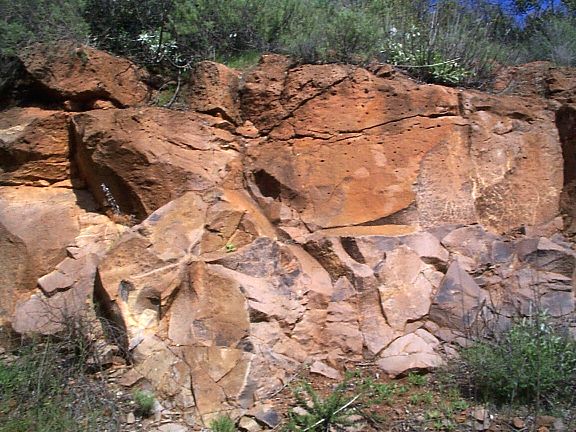 ---
---
Vegetation Series
- To get around these problems, many current vegetation classification schemes use a much-more detailed local classification, such as having ~50 types of chaparral.
- This helps to capture the huge range of natural diversity, to help make sure that rarer elements are preserved.
- Of course, it no longer provides a simple view into our plants!
- Enough discussion: let's look at the SRP and see how well these plant communities / habitats work out.
---
Google Satellite Maps Of The SRP
 ---
---
Topo Map Of Adobes To Mesa de Burro
 ---
---
 ---
---
 ---
---
 ---
---
 ---
---
 ---
---
 ---
---
 --
--
 --
--
 --
--
 --
--
 --
--
Vernal Pools
- The Main Vernal Pool is arguably the top attraction at the SRP:
- Nowhere else in Southern California can one so easily visit a vernal pool
- It is a HUGE Vernal Pool; actually a Vernal Lake
- It is an extremely-threatened habitat
- It contains beautiful plants and animals, who all have amazing stories.
- There's a beautiful boardwalk over part of the Pool, allowing you to observe the flora and fauna up close.
- A vernal pool is perhaps the most challenging habitat for a creature. Our main vernal pool floods for anywhere from days to 6 months, yet is bone dry for months, and sometimes years, with temperatures reaching 100 degrees in the summer.
- Vernal Pool Pictures Versus Time
--


 --
--
- END PLANT COMMUNITY TALK
- Time for a break, if we haven't had one earlier
- Pictures from Santa Margarita Ecological Reserve
- Bonus talk after break:
- Why are the SRP and California floras so interesting?
- How did our plants and plant communities originate?
- What stories does the Santa Rosa Basalt tell?
---
Why Is The SRP Flora Interesting?
- Why are the SRP and California floras so interesting?
- How did our plants and plant communities originate?
- What stories does the Santa Rosa Basalt tell?
--
Global biodiversity:
 ---
---
Clearly, areas near the Equator that receive lots of rain have the highest biodiversity by far, over twice as many unique species as we have.
Outside those areas, the highest biodiversity is found in Mediterranean climates like ours. We have about twice as many unique species as are found in similar areas in the rest of the U.S.A.
What's so special about Mediterranean climates?
- The absence of summer rainfall, coupled with good winter rainfall and a climate kept temperate by the nearby ocean, with winds from the ocean.
- Areas with such climates in general have hugely varied topography which creates a large number of ecoregions. ("From the desert to the sea...")
What happened here? Why do we have such a climate?
--
To understand why our flora is so interesting, we also need a bit of history: geologic and floral history. It's a fascinating story, and one which we can see right here at the SRP. Nowhere else in Southern California is this story told so well!
To understand this story, you need to know that a rough evolutionary timescale is one million years. This is roughly the time for Nature to produce a new species (although known examples range from 0.01 to 100 million years).
If conditions change drastically, Nature begins to adapt new species to the new conditions in one million years, and is essentially finished adapting in ten million years.
How do we know this? Nature has conducted at least ten or so experiments that give us the answer. They're called Mass Extinctions.
--
The real reason dinosaurs went extinct:
 --
--
 --
--
Plant Communities At The SRP: Geological Story
250 Million Years Ago: Forming Pangea

- 100 Million Years Ago: Oregon Volcanoes In Caifornia


The base of those volcanoes is still around as the Woodson Mountain Granodiorite, the white boulders on the Boulder Loop Trail.
The metamorphosed sea floor sediments is still around as the Bedford Canyon Formation, the reddish ~layered rocks on the Punta Mesa Trail and elsewhere.
- 50 Million Years Ago: Angle of Subducting Plate Changes
- Volcanoes move from California to Rocky Mountains
- California becomes FLAT
- 30-0 Million Years Ago: overriding a spreading zone creates the Santa Rosa Basalt.
- Elevation profiles of Santa Ana Mountains:
Just north of Santa Rosa Plateau
 Through Santa Rosa Plateau
Through Santa Rosa Plateau --
--
Plant Communities At The SRP: The Santa Rosa Basalt







 --
--

- After the Santa Rosa Basalt erupted 8-10 million years ago, the San Andreas Fault formed, the Sierra Nevada rose, and the Santa Ana Mountains were created, forming our present-day landscape.
- The Santa Rosa Basalt kept the area dead flat in places where it still exists, and fairly flat in areas where it was only recently removed, which is why the area is now called the Santa Rosa Plateau.
- The Santa Rosa Plateau is the only place in Southern California where you can easily see what the terrain was like 10 million years ago.
--
Plant Communities At The SRP: Climate Changes
- The uplift of the Sierra Nevada altered atmospheric circulation, and Southern California lost its summer rainfall.
Basically, when the West was flat, the airflow was zonal, meaning along latitude lines. With a solid 2 mile high barrier in place, it is easier for the westerly air currents to "go around" the Sierra Nevada then to continue zonal flow.
We still get winter rain because the whole atmospheric circulation pattern in the Northern Hemisphere moves south in the winter, and the Jet Stream occasionally finds its way over Southern California.
- The climate of the Earth has been cooling since about 50 million years ago, and become really cold, with glaciers, in the last 2 million years.

 ---
---
Plant Communities At The SRP: Floral Changes
- Vegetation in Southern California 50 million years ago: a dense tropical rainforest at the coast, with subtropical monsoonal savanna in Southern California inland. Plant densities everywhere were much higher, equivalent to the tropics today.
Typical vegetation found in the fossil record: tree ferns, cycads, and numerous large-leaved evergreen dicots of (now) tropical and subtropical families in the coastal rainforest.
We had in our flora trees now present in eastern North America and in Asia. The tree of heaven, Ailanthus altissima, used to be a native here!
- 30 million years ago: Climate was cooler. Plants migrated toward coast, and were replaced by others more tolerant of coolness, like redwoods. Many species typical of the current Rocky Mountains were present here, along with species now typical of the mountains of Mexico.
---
Plant Communities At The SRP: Floral Changes
- 10 million years ago. Climate gets drier, we begin to lose summer rain.
We lose all tropical plants, which are now in Mexico and south.
Some plants could survive or adapt to these changed conditions, if they had the genetic variation to do so. Annuals could shorten their life cycle and shift it to winter. Perennials could slowly change their growing season from summer to spring.
Some of the plants previously widespread here begin to retreat to riparian (Latin ripa, banks of a river) areas, or to higher elevations where there is less moisture stress.
The surviving vegetation from this time is called the Arcto-Tertiary geoflora, or North Temperate Seed Plants. (Arcto: northern areas; Tertiary: the geologic period from 65 million years ago to the start of glaciation 2 million years ago.) These are true long-term California natives!
Examples: all willows, alders, rushes; most asters, ragweed, dodder, ranunculus, owl's clover, Mariposa lilies, telegraph weed, lupines, peony, checkerbloom, goldenrod, poison oak, viola.
Where do these species live at the Santa Rosa Plateau now?
--
Plant Communities At The SRP: Floral Changes
- New plants come in from southern Rocky Mountains, Arizona and Mexico, called the "Madro-Tertiary geoflora". (Madro: from the region of the various Sierra Madre mountains in Mexico.)
These plants began to evolve ~50 million years ago when the Rockies were formed. They adapted to arid conditions in the rain shadows of the Rocky (and other) Mountains, and were able to move in as the others moved out or up.
Examples: manzanitas, bird's foot fern, snapdragons, locoweed, canchalagua, most lotus, sycamore(!), oaks.
Where do these species live at the Santa Rosa Plateau now?
--
- What have our plants been busy doing the last 2 million years?
- They've been scurrying around!

 ---
---
Plant Communities At The SRP: Why is the Socal Flora Interesting
- Now we can answer the questions:
- "Why are the SRP and California flora so interesting?"
- "How did our plants originate?"
- We have a Mediterranean climate which is found in only five places in the world, with good winter rain but no summer rain.
- We have a landscape with high relief next to a coast, coupled with prevailing westerly winds, producing many different habitats.
- We have relict temperate North American species that have hung around.
- We have newcomers from dry areas in Mexico, Arizona and the Rocky Mountains
- Plants are local; "common species are rare; rare species are common"
- We have had a burst of evolution, still ongoing, from the plants being shuffled together, and shuffled around geographically during the Ice Ages. Examples: oaks, manzanitas.
|




















 ---
---